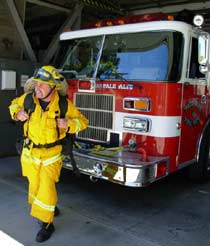

Tuesday - June 20, 2006
SLAC Today is available online at:
http://today.slac.stanford.edu
In this issue:
SLAC Creates Mini-Antarctica to Calibrate NASA Antenna
Safety Today: Fire Season at SLAC
Demolition Projects to Begin Wednesday
 |
 |
|
Tuesday - June 20, 2006 |
|
Members of the ANITA collaboration move a 300-pound block of ice, one of about
70 used in
this week's End Station A experiment.
(Click on image for larger
version.) SLAC Creates Mini-Antarctica
|
||||||||||||||||||||||||||
|
|
||||||||||||||||||||||||||

Fire Season at SLAC
Firefighter Stewart Hill at SLAC's Palo Alto Fire Station 7. (Click on image for larger version.) With the summer heat upon us, fire crews are training for the wildfire season. In the coming weeks, the three crews of Palo Alto Fire Station 7—located on the SLAC site—will fight simulated grassfires, practice fire engine maneuvers, and survey the area for changes in accessibility. Grassfires are unpredictable. As a blaze sucks in oxygen and blares heat, it pulls air currents in new directions, effectively creating its own weather. Between the topography, humidity, and weather, the crews have a lot to handle. In one firefighting simulation, Captain Doug Conn pulls the engine's fire hose for Firefighter Stew Hill, as he heads out with an additional 200 feet of hose strapped to his back. Conn follows with his own hosepack. Operator Catherine Capriles controls discharge of the tank's 500 gallons and watches the terrain so no one gets trapped by the flames. Read more... |
Demolition Projects
|
Events (see all | submit)
Access (see all)Announcements
|
||||||||||||||||||||||||
| | ||||||||||||||||||||||||||
What's Cookin' at the Linear Cafe (see weekly menu)
|
||||||||||||||||||||||||||
|
|
||||||||||||||||||||||||||
 <%
Response.AddHeader "Last-modified", getArticleDate()
'Response.AddHeader "Last-modified","Mon, 01 Sep 1997 01:03:33 GMT"
'Monday, December 06, 2010
%>
<%
Response.AddHeader "Last-modified", getArticleDate()
'Response.AddHeader "Last-modified","Mon, 01 Sep 1997 01:03:33 GMT"
'Monday, December 06, 2010
%>View online at http://today.slac.stanford.edu/ |
||||||||||||||||||||||||||